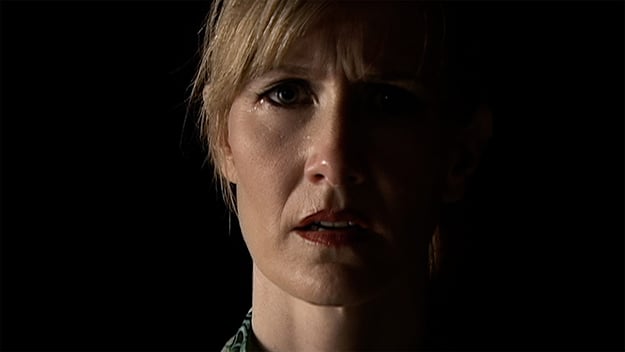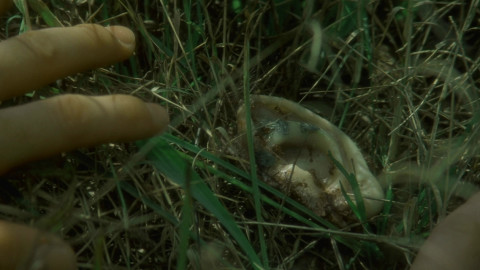I Can’t Explain
This article appeared in the May 12, 2022 edition of The Film Comment Letter, our free weekly newsletter featuring original film criticism and writing. Sign up for the Letter here.

Inland Empire (David Lynch, 2006)
Google “Inland Empire explained,” click around a bit, and you won’t be disappointed: the truth, or at least a halfway persuasive plot synopsis, is out there. That is, unless you’re the type of person—or in this case, the type of David Lynch fan—who reflexively scoffs at the idea that this particular director’s films can or should be explained. Few filmmakers in the history of the medium have had their work so consistently and assiduously strip-mined for Meaning—symbolic, ideological, psychoanalytic, cinephilic—as Missoula’s finest. At the same time, perhaps none have been so vocally and passionately defended by their own coterie of self-proclaimed champions against the scourge of interpretation, be it from tenured academics, salaried critics, or amateur YouTubers, who are characterized uncharitably by this faction as pedants who miss the point of the enterprise by insisting that there is one.
Such are, as the song has it, the Mysteries of Love: the glorious paradox of Lynch’s cinema is that it simultaneously demands and resists exegesis. The teasing defiance of Patricia Arquette in Lost Highway (1997) whispering to her hapless suitor “You’ll never have me” pretty much sums up the director’s well-honed public inscrutability. If you want to know today’s high temperature in Los Angeles, Dave’s your man, but if you want a reading of the final scene of Mulholland Drive (2001), he takes the Fifth. Of all the social-media memes that this highly memeable artist has generated in the Twitter era, the funniest, as well as the most enduring-slash-endearing, is a screen grab of him responding to an interviewer’s hopeful request to elaborate on the spiritual nature of Eraserhead (1977) with a succinct, Sphinx-like demurral: “No.”
Eraserhead can, perhaps, be parsed persuasively on the level of autobiography—as a fever dream of incipient paternal anxiety that somehow anticipated and preemptively perverted the changeling-as-Christ-child imagery of E.T. (1982), with which it would make a swell double bill. The furthest that Lynch ever went toward explaining Inland Empire was to say, over and over again, in press notes, interviews, and even via the film’s official tagline, that it was the story of “a woman in trouble.” In this regard, the director’s 10th feature has the same basic narrative DNA as roughly one-third of his other major works. Alongside Twin Peaks (all three seasons of the show as well as Fire Walk with Me) and especially Mulholland Drive, Inland Empire is a thriller that tries to access, inhabit, and unravel a tragic female subjectivity.
It is the not-so-small matter of in whose mind’s eye we are beholding the film’s parallel narratives that has to be explained (or ignored) in order to properly reckon with Inland Empire. More specifically, is the “woman in trouble” Nikki Grace (Laura Dern), a famous actress contracted to star in a Hollywood movie adapted from an obscure Polish script that is possibly cursed? Or is it The Lost Girl (Karolina Gruszka), a Polish immigrant who, in the film’s opening, sits exiled in a hotel room of the damned, observing multiple planes of televisual reality (including a sitcom about human-sized rabbits) through glassy eyes? On each of the three occasions that I’ve watched Inland Empire since its 2006 premiere—including in the new and controversial HD restoration that brazenly upscales what was once consumer-grade murk into images of pitiless, anodyne clarity—I’ve decided (if not determined) that Nikki and The Lost Girl are one and the same. It’s an explanation that inevitably raises more questions than it answers, one of which is: did our archetypal damsel(s) in distress go looking for trouble (i.e., At What Price Hollywood?) or, as with Laura Palmer, did it somehow find them?
As far as I can tell, the main sources of trouble in Inland Empire are Hollywood and the patriarchy, which Lynch treats as malevolent entities as schizophrenically indivisible from one another as Nikki and The Lost Girl. Here, husbands, directors, and hypnotists alike exert a malign influence on the distaff protagonists. Abusive, imbalanced, and violently doomed male-female relationships serve as one major through line; female solidarity, whether in the form of embrace, witness, or elaborately choreographed group dance numbers, provides a rousing counter-motif. A third major idea in the film is the labyrinth, conjured through the circuitous physical and psychic spaces (call it a multiverse) navigated by lanky, long-legged Nikki as a series of blind alleys, rabbit holes, screen doors, and dead ends—potential escape hatches that all eventually and inevitably lead back to the self.
Such face-to-face self-encounters are historically the stuff of horror movies, and insofar as it’s possible to gauge Lynch’s intentions in making Inland Empire, one imagines “make it scary” scribbled somewhere toward the top of his to-do list. Even leaving aside any potential metaphysical implications about the purgatory of the soul, this may be, just on the level of sound and image, Lynch’s most terrifying film. As brilliant as Dern is at elasticizing her features to suggest a rapidly compartmentalizing consciousness (and brilliant is not too strong a word for her tour-de-force, career-best performance), her director isn’t taking any chances. The bizarrely augmented close-ups that transform Nikki into the minotaur of her own private maze are pure, high-octane nightmare fuel.
To get back to Lynch’s intentions—and he has them, as surely as he has the unconscious impulses he’s written about in his essays on transcendental meditation—the implied institutional and industrial critique of Inland Empire dovetails with all that explicitly horrific imagery. The film’s view of cinema as a hauntological enterprise flecked with the ectoplasm (and blood, sweat, tears, etc.) of past practitioners and fictional subjects alike generates the same sort of terse, seething melancholy that informed Mulholland Drive. But where that film reveled in its deceptively beautiful (and recognizably celluloid) surfaces, Inland Empire exults in ugliness.
The twist is that for all its comparative visual and visceral unpleasantness, Inland Empire is ultimately a more affirmative movie than Mulholland Drive; where Naomi Watts’s Betty/Diane gets inexorably lost, Nikki and The Lost Girl are found—or they find each other, at which point the film simultaneously locates its own poetic equilibrium. I can’t explain why a late shot of Nikki’s silhouette briefly passing and reflecting in the television set in The Lost Girl’s suite resonates with such an ecstatic sense of transcendence. But somehow, in that instant, the movie and its enigmas become completely depressurized; the walls of the labyrinth dissolve into a space of pleasure and possibility. The gloriously goofy coda, which reunites the film’s dance squad of waylaid women while adding a few conspicuously glamorous celebrity ringers (including Laura Harring, Rita from Mulholland Drive) to lip-synch to Nina Simone’s “Sinnerman,” is less a non sequitur than a perfectly eloquent expression of artistic catharsis: an exorcism of bad vibes; a celebration of a job well done; a grace note hit and sustained for its own sweet sake.
Adam Nayman is a critic, lecturer, and author based in Toronto. His latest book, David Fincher: Mind Games, is available from Abrams Books.






